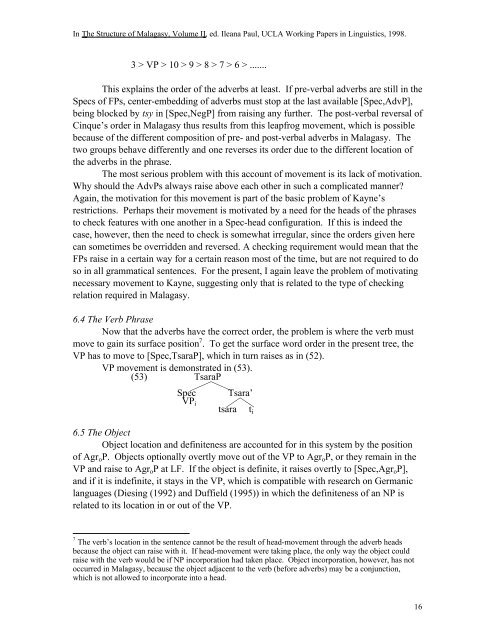Malagasy Adverbs Andrea Rackowski McGill University August 1996
Malagasy Adverbs Andrea Rackowski McGill University August 1996
Malagasy Adverbs Andrea Rackowski McGill University August 1996
Create successful ePaper yourself
Turn your PDF publications into a flip-book with our unique Google optimized e-Paper software.
In The Structure of <strong>Malagasy</strong>, Volume II , ed. Ileana Paul, UCLA Working Papers in Linguistics, 1998.<br />
3 > VP > 10 > 9 > 8 > 7 > 6 > .......<br />
This explains the order of the adverbs at least. If pre-verbal adverbs are still in the<br />
Specs of FPs, center-embedding of adverbs must stop at the last available [Spec,AdvP],<br />
being blocked by tsy in [Spec,NegP] from raising any further. The post-verbal reversal of<br />
Cinque’s order in <strong>Malagasy</strong> thus results from this leapfrog movement, which is possible<br />
because of the different composition of pre- and post-verbal adverbs in <strong>Malagasy</strong>. The<br />
two groups behave differently and one reverses its order due to the different location of<br />
the adverbs in the phrase.<br />
The most serious problem with this account of movement is its lack of motivation.<br />
Why should the AdvPs always raise above each other in such a complicated manner?<br />
Again, the motivation for this movement is part of the basic problem of Kayne’s<br />
restrictions. Perhaps their movement is motivated by a need for the heads of the phrases<br />
to check features with one another in a Spec-head configuration. If this is indeed the<br />
case, however, then the need to check is somewhat irregular, since the orders given here<br />
can sometimes be overridden and reversed. A checking requirement would mean that the<br />
FPs raise in a certain way for a certain reason most of the time, but are not required to do<br />
so in all grammatical sentences. For the present, I again leave the problem of motivating<br />
necessary movement to Kayne, suggesting only that is related to the type of checking<br />
relation required in <strong>Malagasy</strong>.<br />
6.4 The Verb Phrase<br />
Now that the adverbs have the correct order, the problem is where the verb must<br />
move to gain its surface position 7 . To get the surface word order in the present tree, the<br />
VP has to move to [Spec,TsaraP], which in turn raises as in (52).<br />
VP movement is demonstrated in (53).<br />
(53) TsaraP<br />
3<br />
Spec Tsara’<br />
VP i 2<br />
tsara ti<br />
6.5 The Object<br />
Object location and definiteness are accounted for in this system by the position<br />
of Agr oP. Objects optionally overtly move out of the VP to Agr oP, or they remain in the<br />
VP and raise to Agr oP at LF. If the object is definite, it raises overtly to [Spec,Agr oP],<br />
and if it is indefinite, it stays in the VP, which is compatible with research on Germanic<br />
languages (Diesing (1992) and Duffield (1995)) in which the definiteness of an NP is<br />
related to its location in or out of the VP.<br />
7 The verb’s location in the sentence cannot be the result of head-movement through the adverb heads<br />
because the object can raise with it. If head-movement were taking place, the only way the object could<br />
raise with the verb would be if NP incorporation had taken place. Object incorporation, however, has not<br />
occurred in <strong>Malagasy</strong>, because the object adjacent to the verb (before adverbs) may be a conjunction,<br />
which is not allowed to incorporate into a head.<br />
16
















